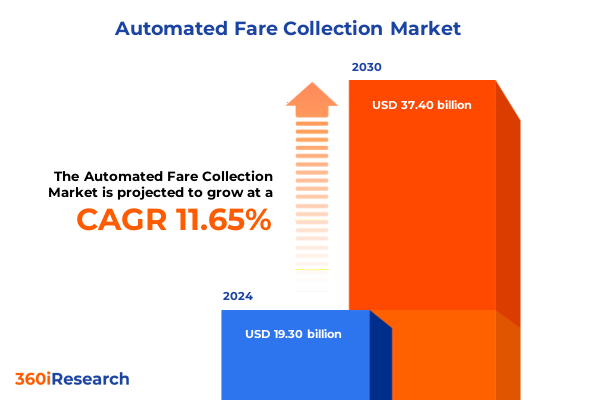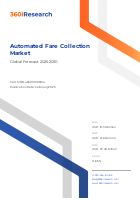The Automated Fare Collection Market size was estimated at USD 19.30 billion in 2024 and expected to reach USD 21.61 billion in 2025, at a CAGR 11.65% to reach USD 37.40 billion by 2030.

Introduction to the Automated Fare Collection Market
Automated fare collection systems have evolved into a critical infrastructure element within the transportation ecosystem. In today’s fast-paced and interconnected world, the demand for efficient, secure, and user-friendly fare collection methods is higher than ever. Over the past decade, rapid technological advancements have given rise to solutions that reduce operational costs, improve customer experiences, and streamline revenue collection processes. This introductory overview sets the stage for an in-depth analysis of current market trends, disruptive innovations, and strategic insights that can help industry leaders navigate an increasingly competitive environment. The journey through digital transformation in fare collection is not merely about replacing outdated processes; it is about reimagining how transactions are conducted in global transit networks. With the integration of advanced technology platforms and data-driven decision making, this market is poised for long-term growth and continuous innovation.
The transformation in fare collection is fueled by a mix of legacy systems being upgraded and new digital solutions being adopted. A combination of government initiatives, private sector collaborations, and consumer demand for convenience has accelerated the adoption of modern payment solutions across multiple transportation segments. As we explore this market further, it becomes evident that automation is no longer a futuristic concept but a current competitive necessity that drives both efficiency and customer satisfaction.
Transformative Shifts in the Automated Fare Collection Landscape
Recent years have witnessed transformative shifts in the automated fare collection landscape. Technological convergence has enabled seamless integration between payment systems and passenger information systems, thus creating robust and flexible frameworks that adapt to changing market demands. The advent of contactless technologies and mobile integration has led to radical improvements in speed, security, and accessibility. Operators and service providers are now moving beyond traditional cash-based systems towards complete digital ecosystems that harmonize hardware and software elements.
Innovations in sensor technology, wireless data transmission, and secure encryption methods are redefining how payments are processed in transit systems. These advancements support real-time monitoring and analytics, enabling decision-makers to optimize transit routes and dynamically adjust pricing strategies. As we witness a shift towards smart city concepts and sustainable mobility, automated fare collection becomes not only a facilitator of efficiency but a cornerstone for city planners and transit authorities. The paradigm shift is further accelerated by regulatory pressures and an increasing need for transparency in public expenditure. Thus, today's landscape is defined by a blend of analytics-driven processes and customer-centric designs that are reshaping the way fare transactions take place across global transportation networks.
Key Segmentation Insights in Automated Fare Collection
A deep dive into market segmentation reveals a multi-layered structure that drives the evolution of automated fare collection systems. An analysis of technology type shows that magnetic stripes continue to be relevant, while optical character recognition and smart cards are pushing the envelope in efficiency and security. Within smart cards, both contact and contactless variants are evolving, each fulfilling specific operational demands and usage scenarios.
When considering the components of these systems, hardware remains essential with readers and validators and sophisticated ticket vending machines forming the backbone, whereas services such as consulting and implementation ensure seamless integration. The software segment, particularly fare management and passenger information systems, is witnessing innovation at a rapid pace. Exploring system type, a distinction emerges among closed loop, hybrid, and open loop systems, each with its unique features that cater to different operational models and security requirements.
Moreover, application-based segmentation outlines distinct market dynamics across various travel sectors. Airports and airlines continue to capitalize on automated systems, with a keen focus on domestic and international flights, while bus networks—spanning private bus operators and public bus services—adopt tailored approaches to meet regional demands. Similarly, railway systems differentiate between metro networks and national rail models to achieve optimal service delivery. End user segmentation further categorizes the market into airline companies, government agencies, and private operators, each subdividing into full-service and low-cost carriers, municipal governments and transport authorities, as well as private transit companies and ride-sharing firms respectively. Finally, analysis based on payment methods distinguishes card-based payment, mobile payment including E-wallets, and near field communication based options, thereby offering a comprehensive view of market dynamics and opportunities for segmentation-based growth.
- Technology Type
- Component
- System Type
- Application
- End User
- Payment Method
Regional Insights in Automated Fare Collection
The global landscape of automated fare collection systems is segmented into distinct regions, each presenting unique growth opportunities and challenges. In the Americas, technological adoption is driven by large-scale modernization projects and significant investments in transportation infrastructure. The region's market is marked by a proactive embrace of digital solutions that reduce transaction times and integrate seamlessly with broader urban mobility strategies.
In Europe, the Middle East, and Africa, a combination of mature transit systems and emerging markets has led to diverse application scenarios. Advanced economies in Europe benefit from legacy system integration with new technologies, while many regions in the Middle East and Africa are in the midst of rapidly building new infrastructures that include smart payment solutions, ensuring scalability and enhanced security. Asia-Pacific stands out as a region with dynamic urban growth and a strong push towards tech-driven solutions, where densely populated cities require innovative and scalable fare collection technologies. Here, significant investments in digital infrastructure support the integration of multi-modal transport options, ensuring that fare collection systems evolve in tandem with local travel demands and sustainability agendas.
- Americas
- Asia-Pacific
- Europe, Middle East & Africa
Key Companies Shaping the Market
Market leadership in the automated fare collection arena is defined by a cadre of established companies driving innovation and setting industry benchmarks. Firms such as Advanced Card Systems Ltd. and Advantech Co., Ltd. have positioned themselves at the forefront by leveraging cutting-edge technologies in smart card solutions and advanced payment systems. The European company Atos SE has contributed significantly to the digitization of transportation networks through sophisticated integration and analytics capabilities, while Cubic Corporation continues to redefine fare management systems. Enghouse Systems Limited, with its comprehensive range of transit solutions, and GMV Innovating Solutions S.L. have consistently adapted to emerging market trends.
Indra Sistemas, S.A. and Lecip Holdings Corporation have introduced pioneering strategies that emphasize both efficiency and customer experience. The technological prowess of LG CNS Co. Ltd. and Longbow Solution Sdn. Bhd. is evident in their robust hardware and software solutions dedicated to transit systems. Masabi Ltd. has rapidly gained recognition for its mobile-first payment platforms, and NEC Corporation has made significant contributions in modernizing ticket vending and fare validation. Nippon Signal Co., Ltd. and NXP Semiconductors N.V. enhance the reliability and security of fare collection devices, while Samsung SDS Co., Ltd. and Scheidt & Bachmann GmbH drive innovation in both service integration and system scalability. These diverse players collectively shape a competitive market landscape where continuous innovation and user-centric approaches remain paramount.
- Advanced Card Systems Ltd.
- Advantech Co., Ltd.
- Atos SE
- Cubic Corporation
- Enghouse Systems Limited
- GMV Innovating Solutions S.L.
- Indra Sistemas, S.A.
- Lecip Holdings Corporation
- LG CNS Co. Ltd.
- Longbow Solution Sdn. Bhd.
- Masabi Ltd.
- NEC Corporation
- Nippon Signal Co., Ltd.
- NXP Semiconductors N.V.
- Samsung SDS Co., Ltd.
- Scheidt & Bachmann GmbH
Actionable Recommendations for Industry Leaders
For decision-makers and industry leaders looking to capitalize on market shifts, a series of strategic recommendations can drive sustained growth and operational excellence. It is essential to prioritize investment in technology integration and digital transformation that align with the evolving needs of urban mobility and public transportation systems. Leaders should focus on consolidating legacy systems with new digital interfaces that offer real-time analytics, ensuring transparency and efficiency in fare collection and management.
Building strategic partnerships with technology providers and consulting experts can accelerate the adoption of innovative systems, supporting the design of scalable solutions that can accommodate growth while ensuring security standards. Continuous assessment and refinement of data management practices are necessary to harness the potential of emerging technologies such as mobile payments and near field communication. Moreover, engaging with local stakeholders and regulatory bodies can lead to the development of systems that are not only compliant but also tailored to regional needs and cultural nuances. Leveraging insights from comprehensive market research should also prompt industry leaders to consider diversified investment strategies, enabling them to explore both high-end technological ventures and cost-effective solutions for varied market segments.
Ultimately, proactive strategic planning, coupled with an agile approach to technology adaptation, can help leaders position themselves as pioneers in the implementation of futuristic fare collection and transit payment systems, ensuring competitive differentiation and enhanced customer satisfaction in an ever-evolving market landscape.
Ask ResearchAI anything
World's First Innovative Al for Market Research
Conclusion and Future Outlook
The analysis of the automated fare collection market underscores the significant advances made over recent years, juxtaposed with emerging trends that promise to reshape the industry landscape. As technology continues to evolve, both digital innovation and system integration are set to drive improvements in operational efficiency and customer engagement. The journey of transformation, rooted in detailed segmentation and geographical analyses, reveals that the market is on the verge of achieving significant synergies across various transit modes and payment methods.
Key findings indicate that modernization initiatives, regional diversification, and competitive market dynamics align to create fertile ground for further technological advancements. The insights presented not only highlight current market trends but also pave the way for strategic investments and collaborations. As transit authorities and private operators move towards increasingly automated and intelligent solutions, the implications for enhanced service delivery and operational efficiency become ever more significant. In summary, the future of automated fare collection promises streamlined processes, improved integration, and greater overall accessibility, ensuring a robust and innovative transit ecosystem across global markets.
- Preface
- Research Methodology
- Executive Summary
- Market Overview
- Market Insights
- Automated Fare Collection Market, by Technology Type
- Automated Fare Collection Market, by Component
- Automated Fare Collection Market, by System Type
- Automated Fare Collection Market, by Application
- Automated Fare Collection Market, by End User
- Automated Fare Collection Market, by Payment Method
- Americas Automated Fare Collection Market
- Asia-Pacific Automated Fare Collection Market
- Europe, Middle East & Africa Automated Fare Collection Market
- Competitive Landscape
- List of Figures [Total: 29]
- List of Tables [Total: 722 ]
Call-To-Action: Connect with Ketan Rohom for Your Market Research Report
Unlock the full potential of your business strategy by accessing an in-depth market research report on automated fare collection systems. Contact Ketan Rohom, Associate Director, Sales & Marketing, to gain comprehensive insights, tailored recommendations, and a detailed breakdown of market trends and competitive landscapes. Enhance your strategic decision-making process by leveraging the latest data and industry forecasts; reach out today to learn how your organization can benefit from the transformative trends shaping the future of transit payment systems.

- How big is the Automated Fare Collection Market?
- What is the Automated Fare Collection Market growth?
- When do I get the report?
- In what format does this report get delivered to me?
- How long has 360iResearch been around?
- What if I have a question about your reports?
- Can I share this report with my team?
- Can I use your research in my presentation?




